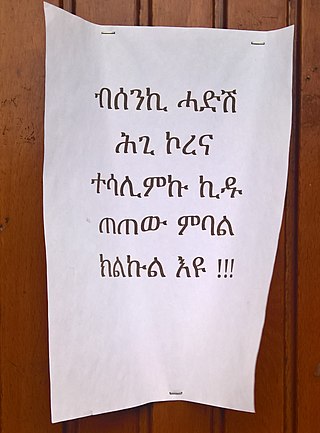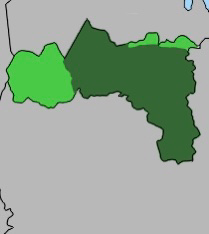
Sources disagree as to the current population of Eritrea, with some proposing numbers as low as 3.6 million and others as high as 6.7 million. Eritrea has never conducted an official government census.
Telecommunications in Eritrea are under the authority of the Government of Eritrea.

Tigrinya is an Ethio-Semitic language commonly spoken in Eritrea and in northern Ethiopia's Tigray Region by the Tigrinya and Tigrayan peoples respectively. It is also spoken by the global diaspora of these regions.

The flag of Eritrea is the national flag of Eritrea. It was adopted on 5 December 1995. The flag combines the basic layout and colors from the flag of the Eritrean People's Liberation Front with an emblem of a wreath and an upright olive branch derived from the Eritrean flag from 1952 to 1962.

The music of Eritrea, is a diverse mix of traditional and popular styles originating from ancient to modern times. The nine major ethnic groups of Eritrea—Afar, Bilen, Hedareb, Kunama, Nara, Rashaida, Saho, Tigre and Tigrinya—celebrate autonomous music-making expressed through a rich heritage of vocalists, instrumentalists and activities within the country and throughout the international diaspora. The country's music is informed by a range of ethnolinguistic group dynamics in the region, by its shared pre-colonial history with and revolutionized independence from Ethiopia, and by its exposure to globalized American music in the mid-twentieth century.

The Eritrean Liberation Front, colloquially known as Jebha, was the main independence movement in Eritrea which sought Eritrea's independence from Ethiopia during the 1960s and the early 1970s.

The Kunama are an ethnic group native to Eritrea. They are one of the smallest ethnic communities in Eritrea, constituting only 4% of the population. Most of the estimated 260,000 Kunama live in the remote and isolated area between the Gash and Setit rivers near the border with Ethiopia. The Kunama people have ancient ancestry in the land of Eritrea. In the 2007 Ethiopian census, however, the number of Kunama in Tigray has dropped to 2,976 as the remaining 2,000 or so members of this ethnic group have migrated into the other regions of Ethiopia.

The mass media in Ethiopia consist of radio, television and the Internet, which remain under the control of the Ethiopian government, as well as private newspapers and magazines. Ten radio broadcast stations, eight AM and two shortwave, are licensed to operate in Ethiopia. The major radio broadcasting stations include Radio Fana a private station, Radio Voice of One Free Ethiopia, and the Voice of the Revolution of Tigray. The only terrestrial (broadcast) television networks are government owned and include EBC and other regional stations. In keeping with government policy, radio broadcasts occur in a variety of languages including Amharic, Afaan Oromo, Tigrigna, and more. There are also many video sharing websites which are a popular way of getting information as well as entertainment in Ethiopia.

Eri-TV is an Eritrean state-owned television network. Headquartered in the nation's capital Asmara, it broadcasts 24 hours a day. The station offers around-the-clock news bulletins, talk shows, and propaganda programs. Eri-TV has a large viewership base outside of Eritrea, which the state-run channel acknowledges and utilizes to communicate with Eritreans living abroad. The network has an estimated 1–2 million weekly viewers. Eri-TV recognizes Eritrean Minority Culture and has largely adopted an equal time share between each of the country's spoken languages. Eri-TV is governed and funded by the Eritrean Ministry of Information.
Seyoum Tsehaye is a jailed Eritrean journalist. At independence in 1993, Tsehaye was named to the head of Eri-TV, the Eritrean state broadcaster. He was arrested in September 2001 when President Isaias Afewerki closed all non-governmental media sources. In December 2007, Seyoum was named Reporter of the Year by Reporters Without Borders. As of January 2016, he was known to be alive, being held at Eiraeiro prison.

Eritrea is a country in the Horn of Africa. Eritrea is the Italian form of the Greek name Ἐρυθραίᾱ, meaning "red [land]". With its capital at Asmara, it is bordered by Sudan in the west, Ethiopia in the south, and Djibouti in the southeast. The northeastern and eastern parts of Eritrea have an extensive coastline along the Red Sea, directly across from Saudi Arabia and Yemen. The nation has a total area of approximately 117,600 km2 (45,406 sq mi), and includes the Dahlak Archipelago and several of the Hanish Islands.

Eritrea, officially the State of Eritrea, is a country in the Horn of Africa region of Eastern Africa, with its capital and largest city at Asmara. It is bordered by Ethiopia in the south, Sudan in the west, and Djibouti in the southeast. The northeastern and eastern parts of Eritrea have an extensive coastline along the Red Sea. The nation has a total area of approximately 117,600 km2 (45,406 sq mi), and includes the Dahlak Archipelago and several of the Hanish Islands.

The Eritrean National Salvation Front is an Eritrean opposition group in-exile. The organisation had an armed wing which fought the Eritrean government, and a radio program that operates outside of Eritrea.
Radio Erena is a Paris-based radio station which broadcasts news in Tigrinya and Arabic into Eritrea. The two-hour daily broadcasts focus on Eritrean politics as well as the migration situation in Europe. The station is headquartered in the 13th arrondissement of Paris, with financial support from Reporters Without Borders. It uses satellite, the internet, and a mobile app to broadcast into Eritrea, where it is the only independent radio station.
Freedom Friday one of the few political opposition organizations in Eritrea as of 2017. Also known as the Arbi Harnet project, this opposition movement seeks to empower Eritreans to publicly challenge the Isaias Afwerki government. According to former diplomat Fathi Osman, there are approximately 5,000 activists out of 6 million Eritreans, and many choose to act in opposition before fleeing the oppressive country. This movement started under the "Empty the Street" Campaign, which was inspired by the Arab Spring movements. However, due to the political culture in Eritrea, youthful citizens were unable to gather to organize mass protests. The official date the movement began was November 11, 2011 when original members made calls and sent messages around the country to join in protesting for democratic changes. The movement as of 2020 is led by Ephrem Tewelde, and has managed to recruit and mobilise new members. Ephrem Tewelde and Tsigabu Asmelash send weekly radio program on short wave and satellite, focusing on the future Eritrea and presenting national plan that covers every aspect of the society. The movement claims that it is reaching new heights in introducing new projects to avail independent internet access for the entire nation. Freedom Friday is claimed to have mobilised community leaders that will help the transition from dictatorship to democracy.

Although the Eritrean constitution guarantees freedom of speech and press, Eritrea has been ranked as one of the worst countries in terms of freedom of the press. As of 2004, the press in Eritrea under the government led by Isaias Afwerki remained tightly controlled.

Dimtsi Weyane is an Ethiopian news-based television and radio network headquartered in Mekelle, Tigray, Ethiopia. Owned by Dimtsi Weyane Tigray P.L.C., it first launched as a radio station in 1980 and in 2018 launched a satellite television channel. The channel broadcasts programming mainly in Tigrinya with some programming in Amharic, Oromo and English.
Asmarino or Asmarino Independent Media is an Eritrean diaspora news website created in 1997.
Awate or awate.com is a United States-based Eritrean news website.

The Tigray Defense Forces, colloquially called the Tigray Army, is a paramilitary group located in the Tigray region of Ethiopia. It was founded by former generals of the Ethiopian Military in 2020 to combat federal forces enforcing national government mandates in the Tigray region, culminating in 2020 with the outbreak of the Tigray War. The TDF has made use of guerilla tactics and strategies. Human rights groups including Amnesty International and Human Rights Watch have reported that the TDF has committed war crimes against civilians including gang rape and extrajudicial killing during their occupation of both the Afar and Amhara regions. According to the Ethiopian Ministry of Justice, TDF combatants have been found liable for upwards of 540 civilians casualties. as of 28 December 2021.










